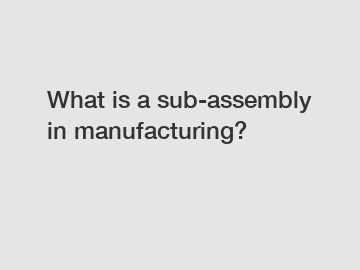What is a sub-assembly in manufacturing?
What is a sub-assembly in manufacturing? .
In the world of manufacturing, efficiency is key. To achieve this, manufacturers often employ the use of sub-assemblies. But what exactly is a sub-assembly, and how does it contribute to the overall production process? Let's delve into the topic and explore the various aspects surrounding sub-assemblies in manufacturing.
1. Definition and Purpose of Sub-Assembly.

A sub-assembly is a smaller component of a larger assembly. It is a standalone unit that is manufactured separately and later integrated into the final product. The purpose of using sub-assemblies is to streamline the manufacturing process, reduce production costs, and enhance overall efficiency. By breaking down complex assemblies into smaller, manageable units, manufacturers can optimize their workflow and improve productivity.
2. Dividing Complex Assemblies.
One of the primary reasons for utilizing sub-assemblies is the ability to divide complex assemblies into more manageable units. This allows manufacturers to concurrently work on different parts of the overall assembly, reducing the time required for production. For example, in automobile manufacturing, sub-assemblies such as engines, transmissions, and electrical systems can be produced independently and then incorporated into the final vehicle, ensuring a smoother manufacturing process.
3. Workflow Optimization.
By using sub-assemblies, manufacturers can optimize their workflow and eliminate bottlenecks. Each sub-assembly can be assigned to a specific team or department, allowing them to focus on their specialized area of expertise. This division of labor increases efficiency as each team can work simultaneously, reducing overall production time. Additionally, sub-assemblies often undergo thorough quality control before integration, minimizing the chances of errors or defects in the final product.
4. Cost Reduction.
Sub-assemblies play a crucial role in cost reduction during the manufacturing process. Since smaller sub-assemblies can be produced independently, manufacturers can outsource or specialize production, often resulting in reduced costs. By utilizing specialized suppliers or subcontractors for certain sub-assemblies, manufacturers can benefit from economies of scale, bulk purchasing discounts, and expertise, leading to cost savings. Furthermore, using sub-assemblies also minimizes the need for rework, as any defects or issues can be identified and rectified before integration, reducing wastage.
5. Flexibility and Customization.
The use of sub-assemblies provides manufacturers with greater flexibility and customization options. By breaking down the assembly into smaller units, it becomes easier to modify or customize individual components. This flexibility is particularly valuable in industries where product variations or customization is in high demand. For example, electronic devices such as smartphones can be customized by incorporating varied sub-assemblies to cater to different market needs. This adaptability allows manufacturers to swiftly respond to changing consumer preferences, ultimately boosting customer satisfaction.
6. Streamlined Maintenance and Repair.
Sub-assemblies also simplify maintenance and repair processes. As each sub-assembly is a standalone unit, it becomes easier to diagnose and fix issues. Instead of disassembling the entire product, technicians can identify the problematic sub-assembly and focus their efforts on repairing or replacing that specific component. This targeted approach not only saves time but also reduces costs associated with maintenance and extends the overall lifespan of the product.
In conclusion, sub-assemblies play a vital role in the world of manufacturing. They offer a range of benefits, including improved efficiency, cost reduction, flexibility, and simplified maintenance. By breaking down complex assemblies into smaller, manageable units, manufacturers can optimize their workflow, streamline production, and deliver high-quality products to the market. Embracing the concept of sub-assemblies is an effective strategy for manufacturers aiming to stay competitive in today's fast-paced manufacturing landscape.
Are you interested in learning more about stator lamination welding, Sub-assembly production, custom stamped stator and rotor cores? Contact us today to secure an expert consultation!



Comments
0